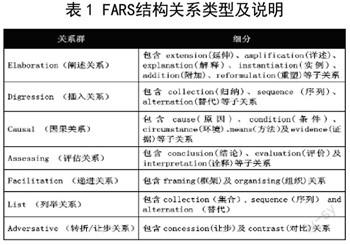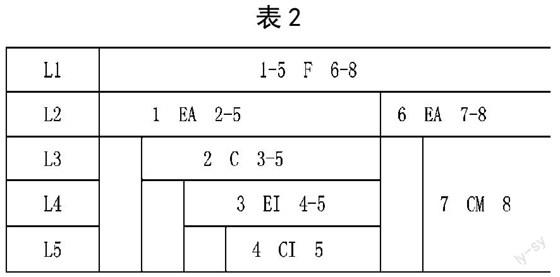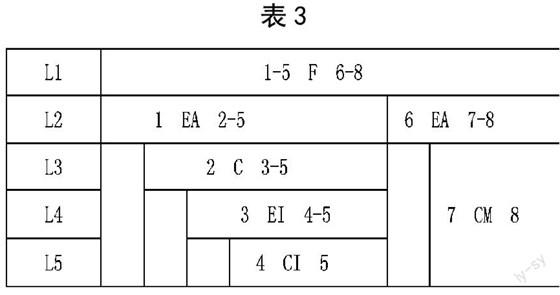運用FARS模型對語篇修辭結構的實證分析
尤麗萍



【摘 要】本文簡要介紹“語篇關系結構分析框架理論”( the Framework for the Analysis of the Relational Structure of Texts,FARS)的7種修辭結構關系類型,并運用該模型對2段語篇進行分析。比較了兩段語篇修辭關系運用的特點,發現語篇一修辭手法運用靈活多樣;而語篇二中部分修辭關系重復出現,過度使用某些直觀形式標記。
【關鍵詞】FARS模型;修辭結構;關系
話語分析近年已發展成為二語習得研究領域的一個重點研究方向(戴煒棟,2005)。大多數語言學家通過分析語篇句子層面的關系來研究語篇內部的銜接與連貫。基于不同的結構關系,美國學者Mann 和 Thompson等人( 1989;1987;1992;1988) 于1983年提出一套關于自然語篇結構描寫的理論。該理論以語篇修辭結構為視角,分析作者對關系結構類型及其表現形式的選擇,故名“修辭結構理論”(Rhetorical Structure Theory,RST)(王偉,1994)。
借鑒了RST理論和早期關于關系結構研究成果,澳大利亞學者Golebiowski (2004)進一步簡化和規范該理論,提出了“語篇關系結構分析框架理論”( the Framework for the Analysis of the Relational Structure of Texts,FARS)。該模型描述了語篇結構關系中不同的功能關系,進而分析作者書寫該語篇的主要目的。雖然FARS 與RST有相似之處,但是FARS用7種關系替代了RST的23種關系,大大減輕了分析者對關系類型的選擇。其次,FARS可運用于各種科研學術論文的語篇研究,也適用于母語為英語或其它語言的作者撰寫的語篇分析。與RST相比,FARS對關系定義的說明更清晰明了,便于理解。FARS模型中各關系的定義及區別請參看Golebiowski 相關文獻,本文不再贅述。7種基本結構關系類型及說明請參見表1。
表1 FARS結構關系類型及說明
(轉引自Golebiowski, 2006, 筆者有改動并翻譯)
本文筆者運用FARS模型對兩段語篇進行修辭結構關系實例分析。語篇一選自Sulllivan(1996) 學術論文的引言部分,語篇二選自某位EFL學習者的習作。這兩段語篇作者分別是英語為母語和英語為外語,本文的另一個目的是比較該兩類作者撰寫的語篇運用修辭結構關系的特點及對外語寫作教學的啟發。
一、分析
(一)語篇一
(1)An often neglected aspect of working with learning styles and strategies is understanding how students sociocultural backgrounds contribute to the way they approach learning in ESL classrooms. (2)For many reasons, ESL teachers are often unable to base assessments of their students learning styles and strategies on information about the way schooling and classroom interaction is organized in the students home countries.(3)This lack of knowledge may result in teachers making inaccurate judgments about their students classroom interaction behavior. (4)For example, ESL teachers who work with Vietnamese students in North America often assume that silence is a cultural attribute of Vietnamese, (5)particularly if they have observed that these students participate minimally in large- and small-group classroom discussions. (6)I argue here that classroom behavior, such as silence, is tied to a complex interaction of broad social and cultural factors.(7) This article draws upon my ethnographic study of classroom interaction in Vietnam to demonstrate the need for ESL teachers (8)to develop an understanding of the role that sociocultural factors play in the way their students approach classroom learning (Sullivan 1996).
根據FARS模型,語篇一可以劃分為8個最小的分析單位(analytical units ),表2直觀地展示了語篇一包含的修辭結構關系和其分析過程:
表2
語篇一有5層從屬關系, 包含7種修辭結構關系。其核心關系是Level1遞進,由框架(units 1-5)及論點(units 6-8)兩個結構段構成。units1-5作者對文章主要議題概述,回顧了前人研究成果,并指出其研究填補了以往研究空白,視為框架關系 。這就為讀者熟悉文章的主題和研究領域提供了相應的背景信息。而units6-8闡述了作者的目的,視為論點關系,因此units6-8比units1-5具有更重要的篇章功能,視為核心功能。
在Level 2中,unit1與units2-5和unit6與units7-8包含了相同的修辭結構關系:闡述修辭結構關系中的詳述(Amplification)。units2-5詳細描述了unit1中所說的“the neglected aspect”。同樣,units 7-8詳細說明了作者在unit6中提到的“a complex interaction of broad social and cultural factors”。
在Level 3中,units2-5可以細分為unit2和units3-5,由因果修辭結構關系中的原因(Cause)關系連接。在該關系中,units3-5作者分析了ESL教師因為(unable to base assessments……)而導致的后果(may result in……),因此units3-5從屬于unit2。在同一層級,unit7和unit8也由因果關系連接,但是unit8中作者明確指出研究目的要通過unit7中所描述的方法實現,故該處視為方法(Means)關系。由該文小標題可以看出,unit7和unit8具有相同的篇章突現(textual prominence)地位。
在Level 4中,units3-5包含闡述修辭結構中的實例(Instantiation)關系,units4-5為unit3的論點提供了實例,FARS模型認為,實例部分的篇章功能較弱。最低層級中,unit4和unit5由因果關系的環境(Circumstance)關系連接。從句unit5中雖然包含連詞“if”,但該句為真實條件句,且“if”能用“after”或“when”替換。因此,該處視為環境修辭結構關系更恰當。由此可見,連詞、介詞雖然象征某種連貫關系,但不是判斷該關系的唯一依據。
(二)語篇二
(1)The PPP method is a variation on Audio-lingualism, (2)which stands for Presentation, Practice and Production.(3) First the teacher presents a language form using a picture or other objects. (4)And then the students practice the language by repeating after the teacher. (5)Finally, the students are asked to use the language in their own sentences. (6)Obviously, it is a very teacher-centered teaching method. (7)Therefore, its alternatives come out:(8) A. Jim Scrivener (1994) puts forward ARC which stands for Authentic use, Restricted use, and Clarification and focus.(9)B. Michael Lewis (1996) offers OHE that allows students to Observe the language, provoke them to Hypothesise about the language and Experiment on the basis of that hypothesis. (10)It is more learner-based than the old PPP method. (11)C. Harmer (1998) suggests an ESA model which stands for Engage, Study and Activate. (12)It follows a more task-based approach.
語篇二可以細分為12個基本分析單位,其修辭結構關系如下:
表3
語篇二包含較多的連接詞,故其修辭結構關系容易辨識。比如,在Level1,該語篇核心修辭結構關系為因果關系,作者使用“therefore”連接units1-6和units 7-12明確了該修辭關系。又如,在Level 3, 根據“First”、“then”、“Finally”可以確定units3-5之間為列舉關系(Listing)。語篇二另一個特點是某些修辭結構關系的重復使用。比如:評估關系中的評價關系(Evaluation)出現三次,分別在Level 2 (1-5 Ev 6)和Level 4 (9 EV 10, 11 Ev 12); 闡述關系(Elaboration)出現兩次,分別在Level 2和Level 3; 而序列關系(Sequencing)的使用多達4次,分別在Level 3和Level 4。
總的來說,語篇一修辭手法運用靈活多樣,而語篇二中部分修辭關系重復出現,修辭手法略顯單一、生硬。語篇二作者過度使用某些直觀形式標記(explicit linguistic signaling),這與ESL寫作教學相關研究的發現相吻合(Study guide: 17):形式標記(如連接詞,句法特征等)往往比隱含的修辭關系更容易傳授給外語學習者。實際教學中,教師往往對形式標記過分強調,作為語言規則傳授給學生。
二、結語
以上簡要介紹了FARS理論的主要觀點和分析方法,作為一種較新的理論,FARS體現了其簡明性和廣泛的適用性。FARS旨在揭示語篇的連貫性及作者的交際目的,這種功能主義分析方法,一定程度擺脫了關聯詞語、語法結構、句法結構等表層語言形式的束縛,通過對語篇修辭關系結構的解析揭示語篇功能,具有一定的說服力。在分析中,FARS理論始終以交際目的為中心,賦予每個關系結構段以目的、作用等功能的解釋,指出語篇整體性及連貫性更多依賴其內部修辭關系結構。
FARS理論的分析方法和研究成果對ESL寫作教學有一定的指導意義。在寫作教學中,教師和學生花了大量時間教學和記憶各種形式標記。但從FARS分析中可以看出,表層語言形式僅為理解語篇提供參考,關系與標記詞之間也不存在簡單的對應關系。另外,教師也應思考如何在寫作教學中加強學生對隱含結構關系的掌握和運用,因為,隱含的修辭結構關系才是構成語篇連貫性的重要手段。
參考文獻:
[1] Mann, W. C., Matthiessen, C. M. I. M., & Thompson, S. A. (1992). Rhetorical structure theory and text analysis. In William C. Mann & Sandra A. Thompson (Eds), Discourse Description: Diverse Linguistic Analyses of a Fund-raising Text pp.39-78.
[2] Mann, W. C., & Thompson, S. A. (1988). Rhetorical structure theory: Toward a functional theory of text organization. Text, 8(3), 243-281.
[3] Golebiowski, Z. 2004. ECL 756 Text Analysis for Language Teaching: Study Guide, Deakin University, Geelong, Vic.
[4] Golebiowski, Z. 2006. The distribution of discoursal salience in research papers: relational hypotaxis and parataxis. Discourse Studies, 8(2), 259-278.
[5] Golebiowski, Z. 2009. Prominent messages in education and applied linguistic abstracts : how do authors appeal to their prospective readers,?Journal of pragmatics, 41 (4), pp. 753-769, Elsevier BV, Amsterdam , The Netherlands.
[6] Golebiowski, Z. 2011. Scholarly criticism across discourse communities, in Salager-Meyer, Fran?oise and Lewin, Beverly A (Eds), Crossed words : criticism in scholarly writing, pp. 203-224, Peter Lang International Academic Publishers, Berlin, Germany.
[7] 王偉.“修辭結構理論”評介(上)[J].國外語言學,1994.4:8-13.
[8] 王偉.“修辭結構理論”評介(下)[J].國外語言學,1995.2:10-16.
[9] 戴煒棟,周大軍.中國的二語習得研究:回顧、現狀與前瞻[J].外國語,2005.160(6):62-70.

